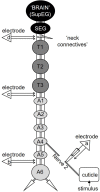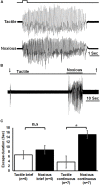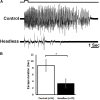Nociceptive Pathway in the Cockroach Periplaneta americana
- PMID: 31496959
- PMCID: PMC6712093
- DOI: 10.3389/fphys.2019.01100
Nociceptive Pathway in the Cockroach Periplaneta americana
Abstract
Detecting and avoiding environmental threats such as those with a potential for injury is of crucial importance for an animal's survival. In this work, we examine the nociceptive pathway in an insect, the cockroach Periplaneta americana, from detection of noxious stimuli to nocifensive behavior. We show that noxious stimuli applied to the cuticle of cockroaches evoke responses in sensory axons that are distinct from tactile sensory axons in the sensory afferent nerve. We also reveal differences in the evoked response of post-synaptic projection interneurons in the nerve cord to tactile versus noxious stimuli. Noxious stimuli are encoded in the cockroach nerve cord by fibers of diameter different from that of tactile and wind sensitive fibers with a slower conduction velocity of 2-3 m/s. Furthermore, recording from the neck-connectives show that the nociceptive information reaches the head ganglia. Removing the head ganglia results in a drastic decrease in the nocifensive response indicating that the head ganglia and the nerve cord are both involved in processing noxious stimuli.
Keywords: extracellular recording; insect; interneurons; nociception; nociceptive receptor; nocifensive behavior.
Figures







Similar articles
-
Suppression of host nocifensive behavior by parasitoid wasp venom.Front Physiol. 2022 Aug 12;13:907041. doi: 10.3389/fphys.2022.907041. eCollection 2022. Front Physiol. 2022. PMID: 36035493 Free PMC article.
-
Dual pathways for tactile sensory information to thoracic interneurons in the cockroach.J Neurobiol. 1995 Jan;26(1):33-46. doi: 10.1002/neu.480260104. J Neurobiol. 1995. PMID: 7714524
-
Responses of thoracic interneurons to tactile stimulation in cockroach, Periplaneta americana.J Neurobiol. 1994 Sep;25(9):1113-28. doi: 10.1002/neu.480250907. J Neurobiol. 1994. PMID: 7815067
-
Cellular organization of an antennal mechanosensory pathway in the cockroach, Periplaneta americana.J Neurosci. 1996 Sep 15;16(18):5830-43. doi: 10.1523/JNEUROSCI.16-18-05830.1996. J Neurosci. 1996. PMID: 8795635 Free PMC article.
-
An antennal-derived mechanosensory pathway in the cockroach: descending interneurons as a substrate for evasive behavior.Brain Res. 1990 Dec 10;535(2):347-52. doi: 10.1016/0006-8993(90)91623-o. Brain Res. 1990. PMID: 2073615
Cited by
-
Evaluation of the chemical defense fluids of Macrotermes carbonarius and Globitermes sulphureus as possible household repellents and insecticides.Sci Rep. 2021 Jan 8;11(1):153. doi: 10.1038/s41598-020-80018-5. Sci Rep. 2021. PMID: 33420232 Free PMC article.
-
Descending control of nociception in insects?Proc Biol Sci. 2022 Jul 13;289(1978):20220599. doi: 10.1098/rspb.2022.0599. Epub 2022 Jul 6. Proc Biol Sci. 2022. PMID: 35858073 Free PMC article. Review.
-
Suppression of host nocifensive behavior by parasitoid wasp venom.Front Physiol. 2022 Aug 12;13:907041. doi: 10.3389/fphys.2022.907041. eCollection 2022. Front Physiol. 2022. PMID: 36035493 Free PMC article.
-
Central GABAergic neuromodulation of nocifensive behaviors in bumble bees.iScience. 2025 Feb 14;28(3):112024. doi: 10.1016/j.isci.2025.112024. eCollection 2025 Mar 21. iScience. 2025. PMID: 40109378 Free PMC article.
References
-
- Diwaker A. B. (1973). Distribution and Orientation of Campaniform Sensilla on the Abdomen of the Cockroaches Periplaneta Americana and Blaberus Cranifer. Emporia, KS: Emporia State University.
-
- Dyakonova V. (2001). Role of opioid peptides in behavior of invertebrates. J. Evol. Biochem. Physiol. 37 335–347.
LinkOut - more resources
Full Text Sources

